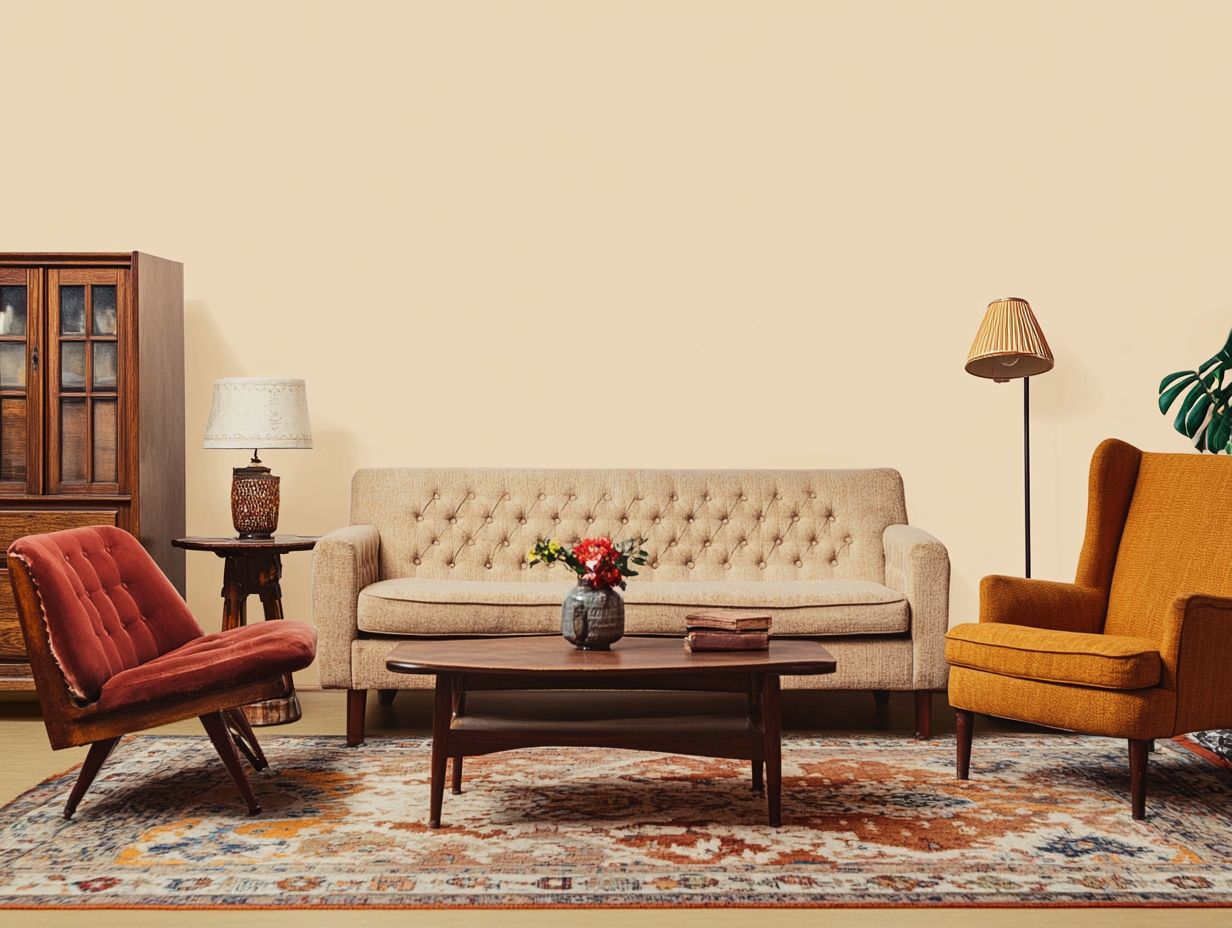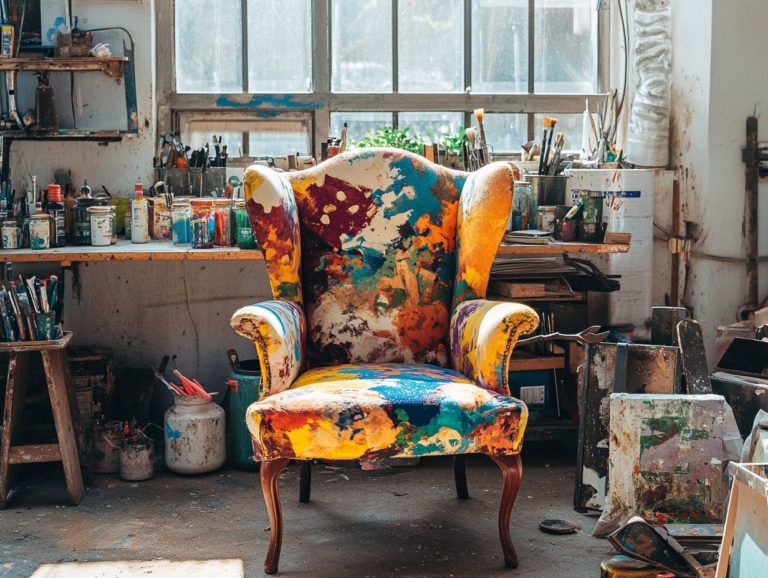The Evolution of Vintage Furniture Styles
Vintage furniture is more than just a relic of the past; it’s a captivating blend of history, artistry, and your unique personal style.
Imagine the elegant lines of the Colonial and Victorian eras, harmonizing beautifully with the bold statements of Art Deco and Mid-Century Modern designs each period has left an indelible mark on the pieces you hold dear today.
This article invites you to explore the rich tapestry of vintage furniture styles, shining a spotlight on popular trends like Shabby Chic and Industrial designs. It also provides you with practical tips for seamlessly integrating these timeless treasures into your modern decor.
Discover how vintage furniture can honor the past while adding personality to your space.
Contents
Key Takeaways:

- Vintage furniture styles have evolved over time, from colonial and Victorian eras to modern shabby chic and industrial designs.
- Technological advancements and social trends have significantly shaped vintage furniture.
- Incorporating vintage furniture into modern decor adds character and charm, with endless possibilities for mixing styles.
Defining Vintage Furniture
Vintage furniture serves as a captivating bridge between the past and present, reflecting the artistic influences and craftsmanship of various eras, from the Colonial and Victorian periods to the Mid-Century Modern and Art Deco movements. These antique pieces not only boast a unique aesthetic appeal but also carry significant historical weight.
Collecting antiques can become a cherished hobby, inviting you to appreciate the intricate details and restoration styles that define vintage furniture across different cultures, particularly in Europe and America.
The allure of vintage furniture lies in its rich tapestry of styles, each resonating with the values and artistry of its time. Unlike modern furniture, which often emphasizes minimalism and function, vintage pieces reveal intricate craftsmanship, ornate detailing, and robust materials that are increasingly rare today, highlighting the impact of vintage furniture on interior design.
A Victorian settee or a Mid-Century chair encapsulates its respective era, offering a narrative and aesthetic that modern designs sometimes miss. By understanding these defining characteristics, you can curate spaces that celebrate bygone eras while creating a unique and inviting atmosphere. This appreciation aligns with the rise of vintage furniture in modern design.
Early Styles of Vintage Furniture
The early styles of vintage furniture showcase the elegance of the Colonial and Victorian eras, each defined by unique designs and exceptional craftsmanship that echo the socio-political landscapes of their time.
In the Colonial period, you’ll notice a focus on robust, practical furniture, influenced by European monarchies and the refined neoclassical aesthetic, which emphasizes simplicity and elegance. For those interested in the evolution of these styles, exploring the history of vintage furniture in America can provide valuable insights. As you transition to the Victorian period, the pieces become more ornate, adorned with intricate carvings and lavish details inspired by the Rococo style and the opulence of the Palace of Versailles.
Colonial and Victorian Eras
The Colonial and Victorian eras each boast unique furniture designs that vividly reflect the artistic influences and societal norms of their times. Colonial furniture often leans towards simplicity and utility, while Victorian pieces dazzle with their elaborate designs and exceptional craftsmanship.
During the Colonial period, artisans prioritized functionality and durability. This focus led to designs characterized by straight lines and natural materials, harmonizing nicely with the Federal and Georgian styles that emerged later. Notable figures like Thomas Chippendale wielded considerable influence over the Victorian aesthetic by introducing ornate elements and refined craftsmanship.
Victorian furniture, in contrast, revels in intricate carvings, plush fabrics, and a delightful array of styles that catered to the rising middle class. This resulted in a captivating blend of opulence and comfort that continues to inspire antique enthusiasts today.
Art Deco and Mid-Century Modern
Art Deco and Mid-Century Modern are two significant movements in vintage furniture design, each showcasing distinctive forms, functionality, and cultural significance that continue to shape contemporary aesthetics.
These movements capture the artistic spirit of their times think bold geometric patterns and luxurious materials defining Art Deco. They also highlight the clean lines and organic shapes that are hallmarks of Mid-Century Modern design.
You can see their influence in today s interiors, where designers seamlessly mix vintage pieces with Scandinavian elements, prioritizing simplicity and practicality.
Art Deco s intricate details perfectly match the minimalist vibe of modern spaces, while Mid-Century Modern furnishings elicit a sense of nostalgia, making them cherished selections among collectors and design aficionados alike.
Popular Vintage Furniture Styles Today

Today, you ll find popular vintage furniture styles like Shabby Chic, Rustic, Industrial, and Scandinavian design seamlessly integrated into modern decor. Discover how these styles can transform your home this season!
This fusion reflects a captivating blend of nostalgia and contemporary sensibilities, catering to a diverse array of tastes that resonate with many.
Shabby Chic and Rustic
Shabby Chic and Rustic styles embody a vintage aesthetic that effortlessly combines charm and comfort. You ll find these styles characterized by distressed finishes, soft color palettes, and a cozy ambiance that invites warmth into any space.
Imagine vintage furniture pieces weathered tables and antique chairs that add character and a sense of history to your home. To enhance your selection, consider understanding different types of vintage furniture fabrics. They evoke nostalgia, bringing back memories of simpler times while seamlessly fitting into contemporary interiors.
Features like lace accents and reclaimed wood create a welcoming atmosphere that harmonizes the old with the new. By mixing elements such as floral patterns and textured fabrics, you enhance the lived-in feel, resulting in spaces that not only look stunning but also encourage relaxation and storytelling.
Industrial and Scandinavian styles offer a modern twist on vintage furniture, blending functionality with aesthetic allure. You ll notice the raw materials that define Industrial design juxtaposed with the simple and elegant design found in Scandinavian style.
These styles showcase simple and practical designs while embodying their distinct historical narratives. The Industrial movement, for instance, traces its roots back to the mid-20th century, emerging from urban warehouses and factories where exposed brick and metal elements were celebrated for their rugged charm.
On the other hand, Scandinavian design blossomed in the post-war period, focusing on light, airy spaces that evoke comfort and warmth.
As time has passed, both furniture styles have evolved, effortlessly integrating into contemporary environments while preserving features that honor craftsmanship and natural materials, showcasing the timeless charm of vintage furniture.
Factors Influencing the Evolution of Vintage Furniture
The evolution of vintage furniture has been intricately shaped by a multitude of factors. Technological advancements and significant social and cultural trends have played pivotal roles, influencing not just design aesthetics but also the materials employed in both the creation and collection of these timeless pieces.
Technological Advancements
Technological advancements have truly transformed the world of furniture design and cabinetmaking. You can really see this evolution in action, as these innovations enable you to embrace the charm of vintage styles while maintaining the exquisite craftsmanship of yesteryears.
With computer-aided design (CAD) software that helps you design and visualize your furniture you can meticulously plan and visualize your creations before making the first cut. With laser-cutting machines at your disposal, you can replicate fine details accurately, allowing for the creation of elegant replicas of classic designs without compromising on authenticity.
Advancements in materials like engineered wood and eco-friendly finishes help you preserve the aesthetic allure of vintage pieces while championing sustainability. These innovations do more than streamline manufacturing; they cultivate a renewed appreciation for traditional methods, enabling you to seamlessly blend modern efficiency with timeless elegance in your designs. To gain deeper insights, consider exploring understanding the craftsmanship of vintage furniture.
Social and Cultural Trends

Social and cultural trends have played a pivotal role in shaping your perception of vintage furniture, igniting an interest in collecting antiques while fostering a deeper appreciation for historical significance.
As society increasingly leans towards sustainability and mindful consumption, you might find yourself recognizing the inherent beauty and value in repurposing and restoring pieces that carry rich narratives. This cultural shift, moving away from mass production towards curated collections, has sparked a renewed admiration for unique, handcrafted items, elevating vintage furniture to a status of desire. To further explore this trend, understand the value of vintage furniture.
You’ll love the character and authenticity that vintage styles offer, embracing a sense of nostalgia that resonates across generations. This evolving mindset encourages you, whether as an enthusiast or a casual collector, to seek out exquisite pieces that not only enhance the aesthetic charm of your home but also reflect your personal values and history. For more insights, explore understanding vintage furniture styles by era.
Tips for Incorporating Vintage Furniture into Modern Decor
Incorporating vintage furniture into your modern decor can create a harmonious space that celebrates the past while embracing contemporary aesthetics. This approach not only brings a unique charm, but also offers a wealth of design possibilities, inspiring your creativity and allowing for personal expression in every corner of your home.
Mixing and Matching Styles
Mixing and matching styles is a brilliant way for you to blend vintage furniture with modern aesthetics, creating visually dynamic spaces that truly reflect your personality and taste.
This fusion not only crafts a unique atmosphere but also sparks a captivating conversation between the old and the new, celebrating the charm of both eras. By incorporating statement pieces like an ornate vintage armchair paired with sleek, minimalistic tables, you can create striking focal points in any room, embracing the trend of mixing vintage furniture with antiques.
To achieve harmony, consider using a cohesive color palette that represents both styles, allowing the intricate patterns of vintage textiles to dance effortlessly with the clean lines of contemporary decor.
Ultimately, your goal should be to cultivate an inviting environment that showcases your personal style while ensuring everything feels visually coherent.
Repurposing and Upcycling Pieces
Repurposing and upcycling vintage furniture pieces not only breathes new life into them but also transforms them into striking focal points that reflect your creativity and commitment to sustainability. By giving these cherished items a new purpose, you embrace a lifestyle that honors history while actively reducing waste.
Techniques like sanding, painting, or reupholstering allow you to express your personal style, breaking free from the constraints of mass-produced alternatives. It’s truly captivating to witness how an old dresser can morph into a chic TV stand or how a dated chair can be revitalized with vibrant fabric. For those interested in style, uncovering the secrets of vintage furniture frame styles can deliver both functional and aesthetic benefits.
Embracing restoration style not only champions sustainable design practices but also cultivates a deeper connection to the pieces that tell unique stories within your living spaces.
Frequently Asked Questions
If you have more questions about incorporating vintage furniture into your home decor or want to explore additional tips and tricks, feel free to reach out or explore more resources!
What is vintage furniture?

Vintage furniture includes pieces that are at least 20 years old. These items often hold significant history or charm.
How has vintage furniture evolved over time?
Vintage furniture styles change with culture and design trends. This evolution has created a rich variety of styles from different eras.
What are some popular vintage furniture styles?
Some well-loved styles include Mid-Century Modern, Art Deco, Victorian, and Industrial. Each style brings its own unique flair.
What sets vintage furniture apart from modern furniture?
Vintage furniture stands out due to its high-quality craftsmanship. These pieces reflect the design trends of their respective eras.
How can I incorporate vintage furniture into my home?
Mix vintage pieces with modern furniture for a dynamic look. Use standout items to create an inviting vintage-inspired theme.
Is vintage furniture always expensive?
Not at all! Vintage furniture prices can vary widely. You can score great deals at thrift stores and online marketplaces.
Ready to find your perfect vintage piece? Start your hunt now!




![Top Vintage Furniture Markets in [Your City]](https://antiquepad.com/wp-content/uploads/2024/08/top-vintage-furniture-markets-in-your-city-gT-768x578.jpeg)

